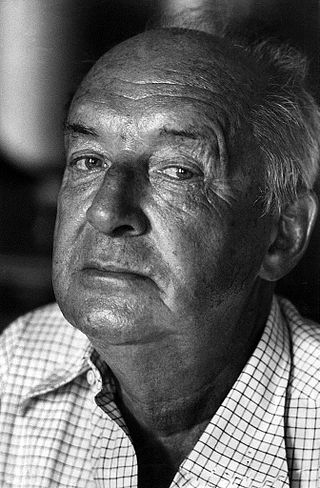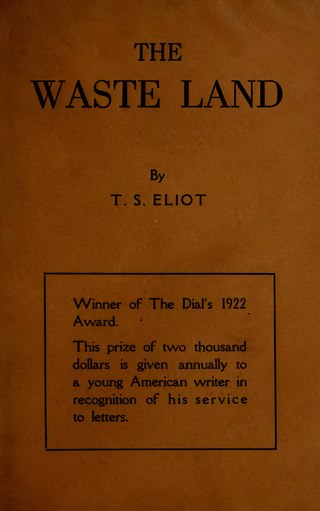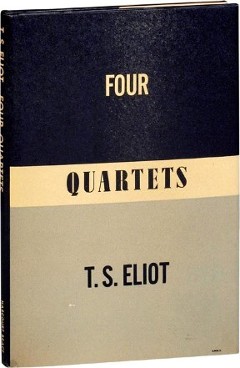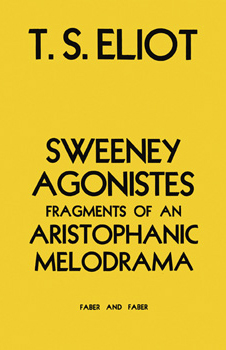Free verse is an open form of poetry, which in its modern form arose through the French vers libre form. It does not use consistent meter patterns, rhyme, or any musical pattern. It thus tends to follow the rhythm of natural speech.

Thomas Stearns Eliot was a poet, essayist, publisher, playwright, literary critic and editor. He is considered to be one of the 20th century's greatest poets, as well as a central figure in English-language Modernist poetry. His trials in language, writing style, and verse structure reinvigorated English poetry. He is also noted for his critical essays, which often reevaluated long-held cultural beliefs.

Vladimir Vladimirovich Nabokov, also known by the pen name Vladimir Sirin, was an expatriate Russian and Russian-American novelist, poet, translator, and entomologist. Born in Imperial Russia in 1899, Nabokov wrote his first nine novels in Russian (1926–1938) while living in Berlin, where he met his wife. He achieved international acclaim and prominence after moving to the United States, where he began writing in English. Nabokov became an American citizen in 1945 and lived mostly on the East Coast before returning to Europe in 1961, where he settled in Montreux, Switzerland.

"The Love Song of J. Alfred Prufrock", commonly known as "Prufrock", is the first professionally published poem by American-born British poet T. S. Eliot (1888–1965). The poem relates the varying thoughts of its title character in a stream of consciousness. Eliot began writing "Prufrock" in February 1910, and it was first published in the June 1915 issue of Poetry: A Magazine of Verse at the instigation of fellow American expatriate Ezra Pound. It was later printed as part of a twelve-poem chapbook entitled Prufrock and Other Observations in 1917. At the time of its publication, "Prufrock" was considered outlandish, but the poem is now seen as heralding a paradigmatic shift in poetry from late 19th-century Romanticism and Georgian lyrics to Modernism.

Margaret Widdemer was an American poet and novelist. She won the Pulitzer Prize in 1919 for her collection The Old Road to Paradise, shared with Carl Sandburg for Cornhuskers.
"Gerontion" is a poem by T. S. Eliot that was first published in 1920 in Ara Vos Prec and Poems. The title is Greek for "little old man," and the poem is an interior monologue relating the opinions and impressions of an elderly man, which describes Europe after World War I through the eyes of a man who has lived most of his life in the 19th century. Two years after it was published, Eliot considered including the poem as a preface to The Waste Land, but was talked out of this by Ezra Pound. Along with "The Love Song of J. Alfred Prufrock" and The Waste Land, and other works published by Eliot in the early part of his career, '"Gerontion" discusses themes of religion, sexuality, and other general topics of modernist poetry.

"Journey of the Magi" is a 43-line poem written in 1927 by T. S. Eliot (1888–1965). It is one of five poems that Eliot contributed for a series of 38 pamphlets by several authors collectively titled the Ariel Poems and released by the British publishing house Faber and Gwyer. Published in August 1927, "Journey of the Magi" was the eighth in the series and was accompanied by illustrations drawn by American-born avant garde artist Edward McKnight Kauffer (1890–1954). The poems, including "Journey of the Magi", were later published in both editions of Eliot's collected poems in 1936 and 1963.

Louis Untermeyer was an American poet, anthologist, critic, and editor. He was appointed the fourteenth Consultant in Poetry to the Library of Congress in 1961.

Madison Julius Cawein was a poet from Louisville, Kentucky.

"The Hollow Men" (1925) is a poem by the modernist writer T. S. Eliot. Like much of his work, its themes are overlapping and fragmentary, concerned with post–World War I Europe under the Treaty of Versailles, hopelessness, religious conversion, redemption and, some critics argue, his failing marriage with Vivienne Haigh-Wood Eliot. It was published two years before Eliot converted to Anglicanism.
"Tradition and the Individual Talent" (1919) is an essay written by poet and literary critic T. S. Eliot. The essay was first published in The Egoist (1919) and later in Eliot's first book of criticism, The Sacred Wood (1920). The essay is also available in Eliot's "Selected Prose" and "Selected Essays".
Nationality words link to articles with information on the nation's poetry or literature.
T. S. Eliot's Ariel poems are those written for Faber and Faber's series of Ariel Poems. All but "Triumphal March" also appear in his book Collected Poems: 1909–1962 under the heading Ariel Poems.

The Waste Land is a poem by T. S. Eliot, widely regarded as one of the most important English language poems of the 20th century and a central work of modernist poetry. Published in 1922, the 434-line poem first appeared in the United Kingdom in the October issue of Eliot's The Criterion and in the United States in the November issue of The Dial. It was published in book form in December 1922. Among its famous phrases are "April is the cruelest month", "I will show you fear in a handful of dust", "These fragments I have shored against my ruins" and the Sanskrit mantra "Datta, Dayadhvam, Damyata" and "Shantih shantih shantih".
Jean Jules Verdenal was a French medical officer who served, and was killed, during the First World War. Verdenal and his life remain obscure; the little that is known comes mainly from interviews with family members and several surviving letters.
The Criterion was a British literary magazine published from October 1922 to January 1939. The Criterion was, for most of its run, a quarterly journal, although for a period in 1927–28 it was published monthly. It was created by the poet, dramatist, and literary critic T. S. Eliot who served as its editor for its entire run.

Four Quartets is a set of four poems written by T. S. Eliot that were published over a six-year period. The first poem, Burnt Norton, was published with a collection of his early works. After a few years, Eliot composed the other three poems, East Coker, The Dry Salvages, and Little Gidding, which were written during World War II and the air-raids on Great Britain. They were first published as a series by Faber and Faber in Great Britain between 1940 and 1942 towards the end of Eliot's poetic career. The poems were not collected until Eliot's New York publisher printed them together in 1943.

The T. S. Eliot bibliography contains a list of works by T. S. Eliot.

Sweeney Agonistes by T. S. Eliot was his first attempt at writing a verse drama although he was unable to complete the piece. In 1926 and 1927 he separately published two scenes from this attempt and then collected them in 1932 in a small book under the title Sweeney Agonistes: Fragments of an Aristophanic Melodrama. The scenes are frequently performed together as a one-act play. Sweeney Agonistes is currently available in print in Eliot's Collected Poems: 1909–1962 listed under his "Unfinished Poems" with the "Fragments of an Aristophanic Melodrama" part of the play's original title removed. The scenes are separately titled "Fragment of a Prologue" and "Fragment of an Agon".

"A Song for Simeon" is a 37-line poem written in 1928 by American-English poet T. S. Eliot (1888–1965). It is one of five poems that Eliot contributed to the Ariel Poems series of 38 pamphlets by several authors published by Faber and Gwyer. "A Song for Simeon" was the sixteenth in the series and included an illustration by avant garde artist Edward McKnight Kauffer. The poems, including "A Song for Simeon", were later published in both the 1936 and 1963 editions of Eliot's collected poems.













